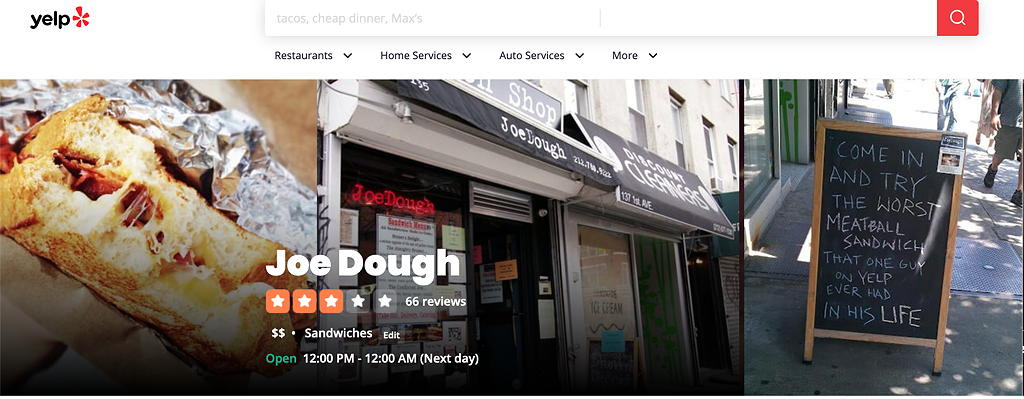The Worst Meatball Sammy: Online Reviews are Opportunities not Albatrosses
“Where do you wanna eat?”
“I don’t know…Where do you wanna eat?”
What is today’s solution for this infuriating circle of indecision? For most of us, it’s whipping out our smartphones and checking our favorite online review sites: OpenTable, Yelp, Google My Business, Zomato. Whether we want the best, freshest seafood in Charleston, the latest Art Deco Miami hotel, or the hottest jazz club to laissez le bon temps rouler in NOLA, 89% of us check for online reviews.
Did you know 89% of us read online reviews before we make a decision? It's true. But only 5-10% of us write those reviews.You can turn the worst review into a plus like the owner did for the worst meatball sammy.So what does this mean in 2021? If you’re in the hospitality, medical, automotive, or clothing industries, you should know your consumers are the ones most likely to read reviews. But every industry needs to pay attention to their user-generated online reviews:
- 93% of shoppers who use mobile to research will complete their purchase.
- 87% of consumers rely on reviews when choosing a restaurant or hotel.
- 79% of shoppers trust online reviews as much as personal recommendations.
- 59% of shoppers look for positive and negative online reviews on Google; 57% use Amazon.
As a business owner, there are many ways to harness the power of user-generated reviews and ensure they work for, not against, you.
Be authentic
It goes without saying that fake reviews are a no-no. If your company accepts paper comment cards, refrain from posting those comments online. Reviews need to be posted firsthand by the customer to create a stronger sense of authenticity. You’ll also see sites adding a note to specify the reviews were posted by consumers as part of a promotion. Consumers are a smart bunch. When they see that disclaimer, they’re going to weigh it differently than those written with the benefit of a promotion.
Be patient
Google warns businesses not to ask customers to write a review in person. It makes us feel uncomfortable and pressured to write something nice when an employee hovers nearby. It diminishes the authenticity of the review. It’s better to send a follow-up request by email to your customers, asking them to leave a review for you. Ask nicely, make it easy to do by including a link, and don’t be pushy about it.
Aim for a variety of sources
Ask a tourist where you should go for dinner in New York. Then ask a local. The answers will be vastly different but could be equally valid choices. This difference is what inspired Bryan Choo to create the Singaporean TheSmartLocal. Choo recognized the difference between tourist and local reviews, and the benefits of capitalizing on both. Take a look at who’s leaving reviews. Are they recent customers? Could they be all locals? Is there another group who isn’t weighing in?
If you’re wondering whether it’s worth the effort to encourage local online reviews, the short answer is yes. More to the point, it’s a factor in Google’s search ranking results for local searches under the heading of prominence.
Respond to negative online reviews
You can’t sit behind your computer reading reviews, silently thanking your fans, and cursing your critics. Negative online reviews have convinced 94% of consumers to avoid a business. And 89% of consumers who are reading reviews are also looking for and reading the response from the business. More than half of customers who leave a negative review expect that business to respond within one week.
No one likes to be criticized, but it’s a part of life and a part of doing business. When you receive a negative online review, don’t respond in the heat of the moment. You should have a friendly, non-defensive response prepared that includes asking the consumer to take the discussion offline in order to resolve it. Add relevant facts to the response to help your audience understand what happened. It might be that the “negative nancy” is a chronic grump. It could also be that your team failed to deliver. And while you’re at it, be sure to respond to nice reviews too. A simple thank you goes a long way in building consumer loyalty.
Everyone’s a critic
We’re all judging numerous things daily. Last night’s meal was tasty. I had a good day at the office. The new car I want is getting negative online reviews on Google. But only 5-10% of consumers are actually writing those online reviews that can make or break your business. And when you factor in the 133% higher conversion rate for customers who read those digital reviews, it only makes sense to embrace them. Even the negative ones.
Perhaps the best lemons-to-lemonade story we know is the one about a 2012 Yelp review for a hole-in-the-wall sandwich shop in NYC. The diner wrote he’d just had the worst meatball sandwich of his life. That bad online review wasn’t handled in the usual way. Instead, the sign writer for Joe Dough Sandwich Shop (now closed) chalked this message on his sidewalk sign: “Come in and try the worst meatball sandwich that one guy on Yelp ever had in his life!”
How could you say no to that?
Want to learn more about how to manage your brand reputation? The EVG team would love to discuss it with you. Give us a call or send an email. Then, later, maybe leave a review for us?



